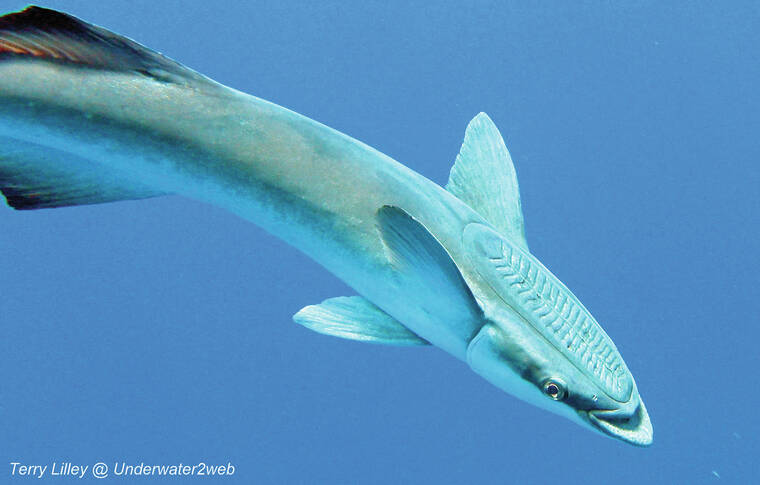Remoras, also called suckerfish are the hitchhikers of the sea They have a suction cup on top of their head, which is a modified dorsal fin used to attach to larger animals.
Ridges on the sucking cup are parallel spines, which create a vacuum to hold onto larger animals like whales, sharks, rays and sea turtles. These bizarre looking fish can grow to about 24 inches long and they will even attach to the bottom of boats to get a free ride.
Omo does not harm the fish it attaches to and sometimes divers will see four or five remora attached to a single large shark or ray. The remora just does not like to swim on its own and tags along for a free ride on big fish looking for a free meal.
When sharks feed they are very messy, so lots of scraps float away in the water. The remora will leave its free ride for a few seconds to grab a scrap, then go back and reattach to their host. This type of feeding allows omo to travel great distances without swimming and get free food when their host feeds. Omo is very much a lazy fish.
Remoras are related to jacks and we have six species in Hawaiian waters, but they not are common to be seen by snorkelers or divers unless doing an open water dive with big sharks like the whale shark or manta rays.
One of the smaller remora species in call leliona, and they are long and thin and will often catch a ride on the top of sea turtles. The smaller remoras will sometimes clean the sea turtles shell and skin of parasites, so they help their host stay healthy.
While diving in the Caribbean with a group of friends we had a very unusual remora encounter. One large omo temporarily let go of its free ride on a big tiger shark when it was chasing a sea turtle to eat.
The remora looked lost and was not happy about swimming on its own, so it went right over to one of the scuba divers and tried to attach on her back next to the tank. The diver did not see the remora, so I swam over and turned her around to see it, but the remora just kept turning with her.
The diver thought I was nuts and could not figure out why I was spinning her around underwater, so I finally gave up and just shot video of this big omo following her around for 20 minutes trying to hold onto her backside. We all had a good laugh watching the video back on the dive boat.
You can see some remoras in action in my marine life educational videos from Hawai‘i, Palau, Caribbean and Mexico up on my webpage at www.underwater2web.com.
•••
Terry Lilley is a marine biologist living in Hanalei Kaua‘i and co-founder of Reef Guardians Hawai‘i, a nonprofit on a mission to provide education and resources to protect the coral reef. To donate to Reef Guardians Hawaii go to www.reefguardianshawaii.org.


